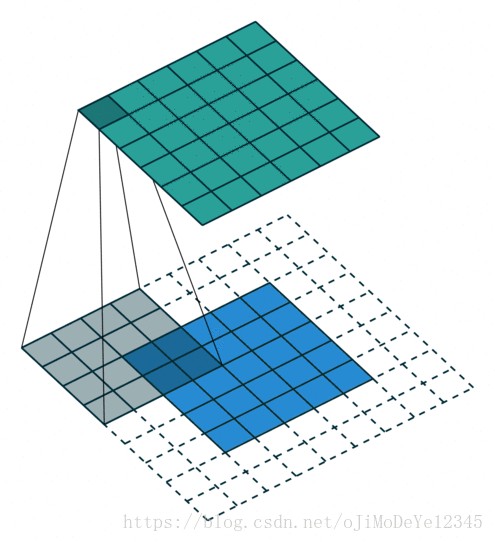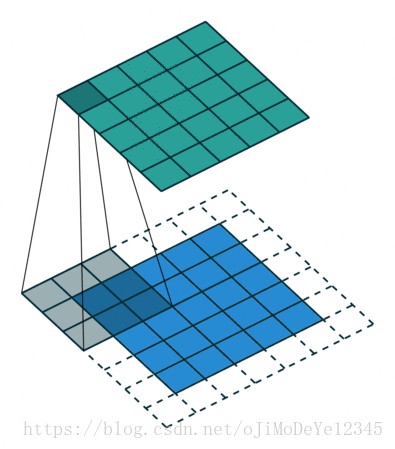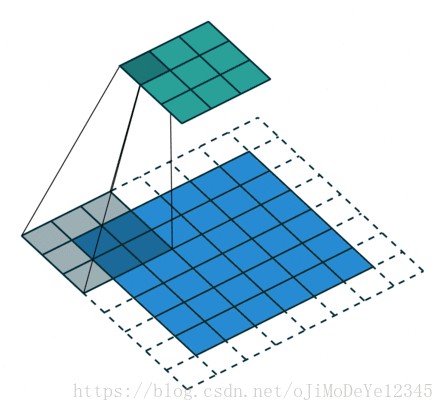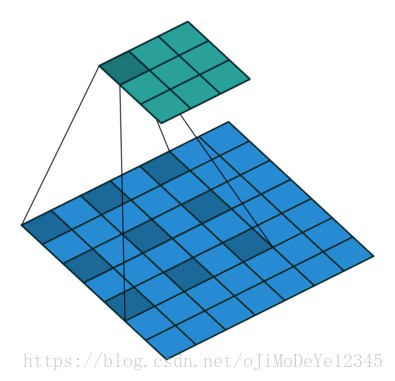ConvLayer 是 Caffe Vision 网络层的一种. Conv 层采用一组待学习的 filters 对输入图片进行卷积操作,每一个 filter 输出一个 feature maps.
Caffe 提供的 Vision 层一般是以 images 为输入,并输出另一种 images,或者是其它类型的数据和维度,也可以是单通道的(1 Channel)的灰度图,或三通道(3 Channel) 的 RGB 彩色图片.
Vision 层一般是对输入 images 的特定区域进行特定处理,得到特定区域对应的输出区域,如,
这里主要是卷积层 ConvLayer.
<h2>1. prototxt 中的定义</h2>
layer {
name: "conv1"
type: "Convolution"
bottom: "data"
top: "conv1"
# filters 的学习率和衰减率
param {
lr_mult: 1
decay_mult: 1
}
# biases 的学习率和衰减率
param {
lr_mult: 2
decay_mult: 0
}
convolution_param {
num_output: 96 # learn 96 filters
kernel_size: 11 # each filter is 11x11
stride: 4 # 步长 4 pixels between each filter application
weight_filler {
type: "gaussian" # 初始化参数 initialize the filters from a Gaussian
std: 0.01 # distribution with stdev 0.01 (default mean: 0)
}
bias_filler {
type: "constant" # initialize the biases to zero (0)
value: 0
}
}
}
<h2>2. Caffe ConvLayer 定义</h2>
Caffe 提供了 Conv 层的 CPU 和 GPU 实现:
- 头文件 -
./include/caffe/layers/conv_layer.hpp - CPU 实现 -
./src/caffe/layers/conv_layer.cpp - CUDA GPU 实现 -
./src/caffe/layers/conv_layer.cu
其输入输出 data 的维度分别为:
- Input - N × C_i × H_i × W_i</p>
- Output - N × C_o × H_o × W_o 其中, $${ H_o = \frac{H_i + 2 * Pad_H- Kernel_H}{Stride_H + 1} }$$ $${ W_o = \frac{W_i + 2 * Pad_W- Kernel_W}{Stride_W + 1} }$$</p>
<h2>3. caffe.proto 中的定义</h2>
message ConvolutionParameter {
optional uint32 num_output = 1; // 网络层输出数
optional bool bias_term = 2 [default = true]; // 是否有 bias 项
// Pad, kernel size, and stride are all given as a single value for equal
// dimensions in all spatial dimensions, or once per spatial dimension.
repeated uint32 pad = 3; // 补零的数量; 默认不补零,即值为 0
repeated uint32 kernel_size = 4; // kernel 大小,如 3-3x3,1-1x1,
repeated uint32 stride = 6; // 步长; 默认值为 1
// Factor used to dilate the kernel, (implicitly) zero-filling the resulting holes.
repeated uint32 dilation = 18; // The dilation; defaults to 1 用于带孔卷积(dilation)
// For 2D convolution only, the _h and _w versions may also be used to
// specify both spatial dimensions.
optional uint32 pad_h = 9 [default = 0]; // The padding height (2D only)
optional uint32 pad_w = 10 [default = 0]; // The padding width (2D only)
optional uint32 kernel_h = 11; // The kernel height (2D only)
optional uint32 kernel_w = 12; // The kernel width (2D only)
optional uint32 stride_h = 13; // The stride height (2D only)
optional uint32 stride_w = 14; // The stride width (2D only)
// 将输入通道和输出通道数分组
optional uint32 group = 5 [default = 1]; // The group size for group conv
optional FillerParameter weight_filler = 7; // The filler for the weight
optional FillerParameter bias_filler = 8; // The filler for the bias
enum Engine {
DEFAULT = 0;
CAFFE = 1;
CUDNN = 2;
}
optional Engine engine = 15 [default = DEFAULT];
// The axis to interpret as "channels" when performing convolution.
// Preceding dimensions are treated as independent inputs;
// succeeding dimensions are treated as "spatial".
// With (N, C, H, W) inputs, and axis == 1 (the default), we perform
// N independent 2D convolutions, sliding C-channel (or (C/g)-channels, for
// groups g>1) filters across the spatial axes (H, W) of the input.
// With (N, C, D, H, W) inputs, and axis == 1, we perform
// N independent 3D convolutions, sliding (C/g)-channels
// filters across the spatial axes (D, H, W) of the input.
optional int32 axis = 16 [default = 1];
// Whether to force use of the general ND convolution, even if a specific
// implementation for blobs of the appropriate number of spatial dimensions
// is available. (Currently, there is only a 2D-specific convolution
// implementation; for input blobs with num_axes != 2, this option is
// ignored and the ND implementation will be used.)
optional bool force_nd_im2col = 17 [default = false];
}
<h2>4. ConvLayer 涉及的参数说明</h2>
Conv 层在 Caffe 定义中涉及的参数:convolution_param.
- num_output(C_o) - filters 数
- kernel_size - 指定的每个 filter 的 height 和 width,也可以定义为
kernel_h和kernel_w - weight_filler - 权重初始化
- type: 'constant' value: 0 默认值
- type: "gaussian"
- type: "positive_unitball"
- type: "uniform"
- type: "msra"
- type: "bilinear"
- bias_term - 可选参数(默认
True),指定是否学习 bias,在 filter 输出上添加额外的 biases. - pad - 补零,可选参数(默认为 0),也可以是
pad_h和pad_w. - stride - 步长,可选参数(默认为 1),也可以是
stride_h和stride_w. - group - 分组,可选参数(默认为 1),如果 group>1,则限制每个 filter 的连续性,分组到输入的一个子集subset 中. 即: 输入和输出通道被分为 group 个组,第 i 个输出通道组仅与第 i 个输入通道组相连接.
<h3>4.1 group 参数</h3>
根据 Caffe 官方给出的说明:
group (g) [default 1]: If g > 1, we restrict the connectivity of each filter to a subset of the input. Specifically, the input and output channels are separated into g groups, and the i-th output group channels will be only connected to the i-th input group channels. group - 分组,可选参数(默认为 1),如果 group>1,则限制每个 filter 的连续性,分组到输入的一个子集subset 中. 即: 输入和输出通道被分为 group 个组,第 i 个输出通道组仅与第 i 个输入通道组相连接.
例如:
假设卷积层输入数据大小为 128×32×100×100,图像数据尺寸为 100×100,通道数为 32,假设卷积 filters 为 1024 ×3 ×3,
在 group 默认为 1 时,即为常见的全连接的卷积层.
当 group 大于 1 时,如 group=2,则卷积层输入 32 通道会被分组为 2 个 16 通道,而输出的 1024 个通道会被分组为 2 个 512 通道. 第一个 512 通道仅与对应的第一个 16 通道进行卷积操作,而第二个 512 通道仅与对应的第二个 16 通道进行卷积操作.
在极端情况下,如,输入输出通道数相同,如都为 32 个通道,group 值也为 32,则,每个输出卷积核 fliter 仅与其对应的输入通道进行卷积操作.
group conv ResNext与Xception——对模型的新思考
ResNeXt - Aggregated Residual Transformations for Deep Neural Networks 论文有关于 Group Convolution 的介绍.
论文阅读理解 - ResNeXt - Aggregated Residual Transformations for DNN
<h3>4.2 dilation 参数</h3>
[论文阅读理解 - Dilated Convolution]
<h2>5. gif 图示</h2>
Github - conv_arithmetic 给出的动图展示效果很不错.
以下图中,蓝色 maps 是输入,青色 maps 是输出.
Blue maps are inputs, and cyan maps are outputs.
- <p>No padding, no strides
 </p>
</p> - <p>Arbitrary padding, no strides
 </p>
</p> - <p>Half padding, no strides
 </p>
</p> - <p>Full padding, no strides
 </p>
</p> - <p>No padding, strides
 </p>
</p> - <p>Padding, strides
 </p>
</p> - <p>Padding, strides (odd)
 </p>
</p> - <p>Dilated convolution - No padding, no stride, dilation
 </p>
</p>